This was published 5 years ago
The Trans-Siberian Railway in winter: The world's longest train route is also the most extreme
By Catherine Marshall
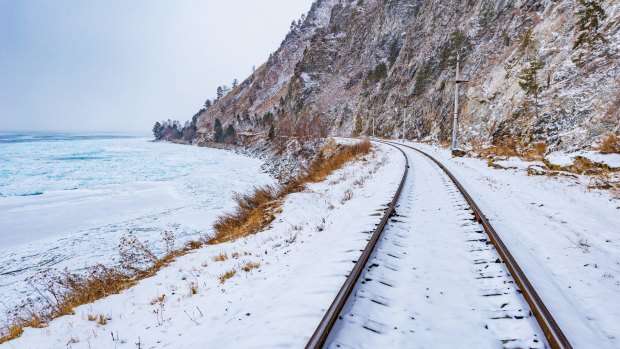
The Tran-Siberian is 9288 kilometres in length, from Moscow to Vladivostok.Credit: Getty Images
Siberia's cold is unfathomable. It wraps its savage fingers around my neck and crushes the tips of my fingers. It grates my lungs with every razor-sharp intake of breath. It freezes my brain so I can no longer comprehend what the Old Believer, an Orthodox priest, is saying. His black cassock is rigid with cold, his beard a cascade of icicles, his words a warm spill promptly vaporised on the chilled air. What on earth possessed us to come to this most infamous of outposts, this far-flung emptiness where people have been sent to die – or to live, improbably – and in this least humane of seasons?
Nine days and more than 5000 kilometres earlier, we're oblivious to what awaits us as we bathe in the weak sunshine that's broken briefly through a snow shower and is casting long shadows and buttery columns along a charming Moscow prospect. The temperature is a mere minus-four degrees – a veritable summer compared to the frozen perdition we will face down the line.
Still, the cold here is impressive. We snap-chill a bottle of wine in the snow that's powdering our hotel windowsill. We blink away whirling snowflakes and wrap scarves around our tender noses while queuing to see Lenin's corpse lying waxy and wan and warmer-than-the-living in his sombre mausoleum. As we walk back from a supermarket one evening, I slip on black ice and am hauled to my feet by two men even as I am falling, even as the contents of my shopping bag are rolling downhill.
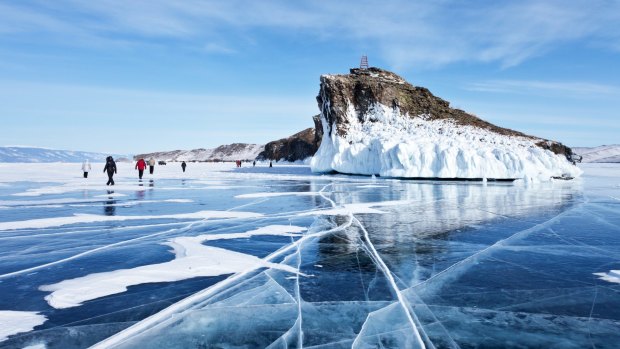
Lake Baikal is so otherworldly, so far beyond our imaginings.Credit: Shutterstock
"Spasibo!" I cry out in response – thank you – and they nod nonchalantly. They are well-practised in the rescue of random ice-trippers, these men.
What are we doing here, in the darkest depths of a Russian winter? Attending to priorities: it's my birthday in early January (a significant one), and to celebrate I'm taking the train from Moscow to Vladivostok. What a pity I wasn't born in June.
I'm joined in my Arctic wanderings by 10 family members – an audacious gang of parents, young adult children and a couple of brave boyfriends (the cold is the least of their worries, I imagine). Swaddled gamely against the extremes, they lug small libraries with which to occupy their minds on this interminable journey, and mental fortitude with which to face off against the infernal cold.
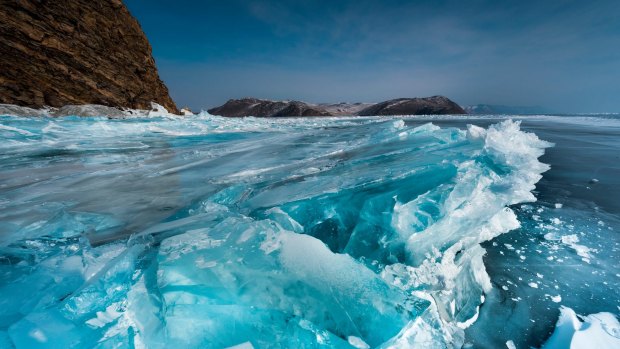
Frozen waves at lake Baikal.Credit: Alamy
COLDER BY DEGREES
At midnight we board the train at Moscow's Yaroslavsky Railway Station, stopping just long enough in the bitter freeze to acknowledge the monument marking the starting point of the fabled Trans-Siberian railway. The route arcs in a broad south-westerly sweep, traversing 9288 kilometres and seven time zones before terminating in Russia's Far Eastern naval garrison, Vladivostok. It is the longest railway line in the world.
The Ural Mountains are cloaked in darkness when we pull into Yekaterinburg in the early hours of the morning. For 33 hours we've peered out from our compact, four-berth compartments at the uncoiling landscape, at fluorescent cities dimming into canvasses of black ink; at forests glittering with diamond snowflakes; at swathes of farmland gradually solidifying into cities then disintegrating again into empty fields of snow. Overzealous heating has shielded us from an ever-changing climate; we step off the train into an incomprehensible minus-18 degrees.
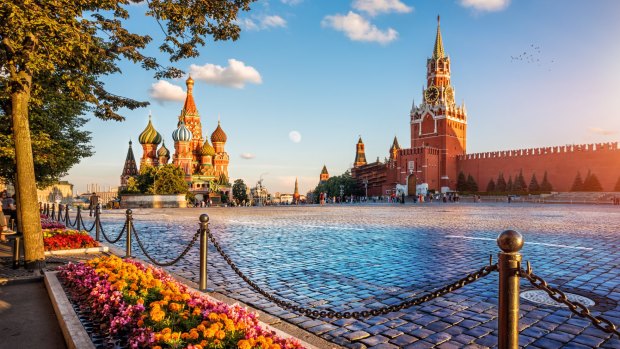
Starting point: The Red Square in Moscow. Credit: Shutterstock
It's New Year's Eve. Yekaterinburg is lit up like a carnival, the Iset River is a boulevard of ice. The Gosudarstvennyy Akademicheskiy Theatre stands like a baroque wedding cake on a bed of snow. Inside, we queue at the coat racks where patrons throw off heavy swaddling to reveal glamorous frocks forced into hiding by the cold. We join them in jubilantly bravo-ing a performance of The Nutcracker, a Christmas spectacle manifesting onstage in vivid counterpoint to the frosted scenes outside. "Zazdarovye!" we cry at midnight, farewelling the old year with shots of vodka and welcoming the new with flutes of champagne.
FROM TSARS TO SAINTS
Yekaterinburg is a city of death and rebirth, of constructivist architecture built on the foundations of the Bolshevik Revolution and the execution of the Romanovs here in 1918. Though writers passing through on their way to Siberia recalled an unpleasantly industrialised settlement, Soviet poet Vladimir Mayakovsky was deeply impressed by the spirit and ideas of the people, says local guide Olga Taranenko.
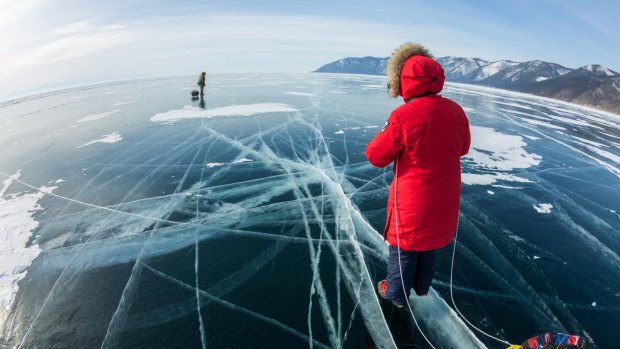
Sledding across the ice of Lake Baikal. Credit: Alamy
"They decided to destroy everything that reminded them of the old regime, and construct a new city."
But the new has been replaced with the old: churches have been re-consecrated and the once-reviled Romanovs – Tsar Nicholas II, his wife and five children – canonised. A cathedral stands on the site where the family died, its red granite walls "reminding us of the bloody events", Taranenko says. Even their once-secret burial site outside the city is now sanctified, a cluster of buildings comprising a monastery dedicated to the Romanov saints. Their remains were removed from here and interred in St Petersburg in 1998.
IN SIBERIA
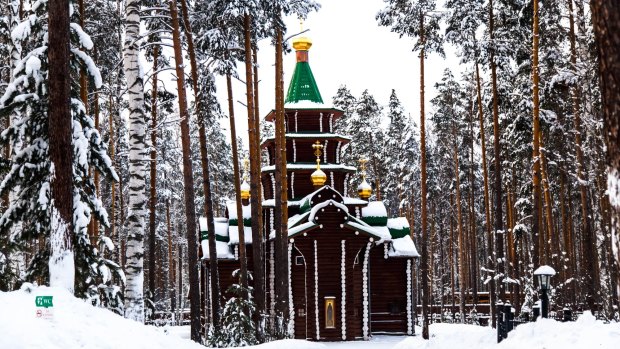
The Temple of St. Sergius of Radonezh - the Monastery of the Holy Imperial Passion-Bearers.Credit: Alamy
It takes 63 hours to reach Ulan-Ude, capital of the autonomous Republic of Buryatia. We sail from Europe into Asia, crossing oceans of snow, passing railway stations licked with bright paint and fitted with neon signs alerting us to the temperature: minus-22 at Omsk, minus-20 at Barabinsk where we emerge from the train's swelter into a cold so strident it cleanses our stale bodies and shocks us awake. We buy pierogi stuffed with cabbage and potato at a platform kiosk and watch as a railroad engineer crawls beneath the train, lies upon the snow-caked tracks and fiddles imperturbably with the frozen undercarriage.
Somewhere near Novosibirsk four men appear in our compartment doorway and sing us a song. They're from Perm, and are on their way to Lake Baikal to ice-skate. We applaud their cheerful ditty, though we've understood not a single word.
"You write about Baikal?" asks one of them, spying my notebook. I nod; he punches the air with his fist. "Baikal you will love," he says. ''Thank you for visiting in its most beautiful season."
On the second day of this leg I awake to flooding, late-morning light. I've missed the Yenisei River and an endlessly evolving landscape. We're fast-forwarding through time, gaining hours as we race away from the sun. Our group sprawls across several compartments, locked in games of chess, trapped inside books, embroiled in conversations or hypnotised by the Siberia scrolling by through ice-rimed windows. At mealtimes, the youngsters squeeze into the parents' compartment for makeshift feasts we've cobbled from shops and stalls along the way: bread and cheese and salami, instant mash, caviar sold by platform hawkers for a handful of rubles.
On the third day, I wake before dawn. We've halted in Irkutsk; I climb from the train into an ethereal gloom. The train recedes along the tracks, its outermost carriages erased by the silvered fog. It's minus-36 degrees, and today I turn 50. Never have I've felt so cold, nor so joyfully alive.
A LAKE FROZEN IN TIME
All day long the train crawls along the south-eastern edge of Lake Baikal. The water sloshes sluggishly, turns gradually to slush and then to solid ice as we curve northwards along the lake's eastern shoreline. Opposite it, fields slope into gullies, snowy whitecaps ripple the plains, fog cushions the tree-line like some mammoth exhalation. We see runnels protruding like ribcages from beneath thin coatings of ice; buckwheat might still be farmed here, says our guide Ksenia Martynova, though after the collapse of the Soviet Union many of Siberia's farms fell into ruin, too.
Lake Baikal is the low-point of our journey; the temperatures plumb those unfathomable depths, tearing the breath from our lungs and freezing the blood in our veins. It's the high point of our journey, too, for this place is so otherworldly, so far beyond our imaginings, it stuns us into wakefulness and renewed gratitude for the world. So extraordinary is this shared experience, it will bind our family forever.
We disembark at Buryatia's capital Ulan-Ude, a city that embodies the great collision between Europe and Asia, Russia and Mongolia, Christian Orthodoxy and Buddhism. Stray dogs wag their tails, oblivious to cold, it seems; residents stride along streets wreathed with glacial condensation.
"The real Siberian is not the person who doesn't feel the cold," says local guide Goldan Lenkhoboev. "It's the person who dresses properly for it."
Our own polar-wear has served us well until now, but the cold seeps into our marrow in the village of Tarbagatay, where Fr Aleksei shows us around the ethnography museum he's curated. It's a flimsy, unheated space filled with artefacts belonging to Old Believers – Orthodox Christians who were exiled or fled from European Russia in the 17th century in the wake of church reforms, and whose way of life has changed little since then. The cold here is so piercing I can barely focus; it's a visceral reminder of the conditions into which Fr Aleksei's people – and so many others – were once cruelly banished.
We've seen not a single tourist on our journey so far, and now we have the whole of Sukhaya village to ourselves – except for the young Russian men doing burnouts in their Ladas on the ice-slicked shores of Lake Baikal. This fabled body of water – the world's deepest lake and the largest freshwater lake by volume – extends beyond the village in a brumous mass. It has put up a valiant fight against the deep freeze: waves heave and buck and petrify midair. The ice splinters beneath our boots, and when we skate on it the next day we notice air bubbles and water lilies trapped beneath its surface.
On Orthodox Christmas Eve, January 6, we drip sweat inside the banya (traditional sauna) at our guesthouse, submit to Martynova's birch whips – said to improve lymphatic flow – then run outside and smother ourselves in snow. Finally, we're learning to embrace the cold.
THE END OF THE LINE
It's another 62 hours from Ulan-Ude to Vladivostok. The frostbitten landscape flicks past our windows like a slideshow. It's inconceivable, from within the confines of this overheated compartment, that the conditions unspooling outside might kill us if we immersed ourselves in them unprotected; the snow-draped fields are beaches of silica, the larch trees jaunty filigrees against a blue sky. Young marines bound for the naval city run for the train, their breath puffs of smoke on the chill air; the temperature is slowly rising: minus 20, minus 15, minus 10, the neon signs say. A cook comes around sporadically with freshly made pierogis; we lie in wait and clear her tray in exchange for a few rubles.
At Khabarovsk the railway doglegs southwards. We will the train to slow down, but at dawn it pulls into Vladivostok. This is a revelation of a city, we will discover, a place of bright skylines and frozen bays, striking harbours and exceptional restaurants. But we're not yet ready to greet it. We linger on the platform – pleasantly bracing at just minus-eight degrees – and pose for a photo beside the monument marking the end of our epic journey. We've travelled 9288 kilometres – a full third of the world's circumferential span. And there's not one of us who wouldn't climb back on that train before it returns to Moscow, and do it all over again.
THE TRANS-SIBERIAN IN NUMBERS
9288 kilometres total length, from Moscow to Vladivostok
1916 the year Moscow and Vladivostok were connected via the railway line
7 number of time zones crossed
60 average speed at kilometres per hour reached by the train
1/3: span of the globe covered by the railway line
7 days it takes to complete the journey, without getting off along the way
16 major rivers crossed by the railway
87 towns and cities the railway passes through
TRIP NOTES
MORE
FLY
Etihad flies to Abu Dhabi twice daily from Sydney and Melbourne and once daily from Brisbane and Perth, with onward connections to Moscow. See: etihad.com. Korean Airlines flies several times a day from Vladivostok to Seoul, with onward connections to Sydney and Brisbane. See koreanair.com
TOUR
Intrepid Travel's 15-day Russia Expedition: Winter Trans-Siberian Adventure is priced from $3055 a person twin share and has many departures beginning from December 2019. Private group bookings are also available. See intrepidtravel.com.au
KEEP WARM
Appropriate winter gear is essential for this journey. For the coldest outdoor excursions, layer clothing in the following sequence: thermal vest and leggings, jeans or thick pants and a long-sleeved shirt, thermal jumper, polar jacket and waterproof shell, tube scarf, beanie, glove liners and waterproof polar gloves. Snow boots paired with warm socks are essential – Sorel and Colombia are highly recommended. Pack lightweight clothing for the train; it will be warm and quite possibly overheated.
STAY SANE ON THE TRAIN
Compartments are compact but comfortable, with two bunks sleeping four people each; clean bedding is provided. There are two toilets with hand basins and cold water at the end of each carriage. A provodnista or provodnik (female or male carriage attendant) is in charge of each carriage; they keep it clean, provide passengers with beverage glasses and ensure the samovar is filled with hot water. It's a good idea to buy a few snacks, teabags or sachets of coffee from them as they receive a small commission from sales and appreciate the custom.
There are regular stops of various durations; schedules are posted in the carriage. There are often kiosks on the platforms or in the stations selling bottled water and food. Some food should also be bought at supermarkets prior to departure since not all trains have dining carriages. The trains are well-used by locals, many of whom will approach foreigners for conversation. Take small gifts from Australia to share with them.
FIVE OTHER JOURNEYS WORTH TAKING IN EXTREMES
DEATH VALLEY IN SUMMER
If you visit the US's Death Valley at the height of summer, you might find out just how hot hot can get: 56.7 degrees as measured in 1913, the second hottest temperature on record. As long as you take all the necessary precautions (such as keeping hydrated and ensuring you have mobile contact) you can enjoy the landscape at its most primordial and without the shoulder-season crowds. Or enter the annual midsummer Badwater Ultramarathon, which starts at 85 metres below sea level and ascends 4000 metres across 217 kilometres and three mountain ranges.
VICTORIA FALLS DURING PEAK WATER
You'll need to take a raincoat if you visit this world wonder in the wet season, when islands upstream from the falls – accessible by boat in the dry season – are drowned by summer's deluge. View the spectacle of hundreds of millions of litres of water a minute gushing into the great cataract separating Zimbabwe from Zambia. Peak water, as it's called, runs from around March to June and (in good news for the bottom line) precedes peak season.
AMERICAN MIDWEST DURING TORNADO SEASON
Eye-of-the-storm itineraries exist for those who dream of observing springtime twisters up-close in a region of the American Midwest known as Tornado Alley. Journeys centre on midwestern states such as Texas, Kansas, Oklahoma and Nebraska during May and June. Sightings aren't guaranteed, but participants are likely to see supercell storms and the impressive lightning shows that often accompany them. See stormchasing.com
ICEFIELDS PARKWAY IN WINTER
In winter practically everything is iced over along this 230-kilometre-long route linking Lake Louise and Jasper in Alberta, Canada: lakes, waterfalls, peaks, forests, glaciers and bitumen. Winter tyres or snow chains are essential. Travel cautiously, dress warmly and stop regularly at lookouts for views of glacier-licked valleys and snow-laden forests. Bears will be hibernating but you'll see bighorn sheep, elk and caribou – and possibly wolves.
KAKADU IN THE WET
Most people assume the NT is off limits during the wet season: too damp, too sticky, too hot. But the wet season is a wild and magical time when waterfalls overflow and floodplains brim with water, intensifying the landscape's lushness and attracting numerous birds. Some roads are closed during the wet (which runs from around November to May) limiting access to sites, and animals are more dispersed; but visitors will have the park almost all to themselves – and it will cost as little as half of what it would in the high season.
FIVE MORE GREAT COLD WEATHER JOURNEYS
EUROPE'S CHRISTMAS MARKETS
These festive markets have been brightening winter-darkened cities since the 16th century. Cities such as Prague, Vienna and Berlin are transformed into charming bazaars selling an assortment of artisanal food, arts and crafts and merry experiences. The markets draw crowds onto light-spangled streets – and help draw travellers who might otherwise visit during the continent's unbearably busy summer season.
QUEBEC'S WINTER CARNIVAL
The people of Quebec City have turned their iciest month, February, into a celebration of all things winter: ice slides, outdoor cinema, dance parties and ice-skating, night parades, snow baths, dog sledding and a canoe race in which competitors paddle along the St Lawrence River through masses of ice.
ANTARCTICA
Strictly speaking, a visit to Antarctica is a summertime jaunt, since this is the season when pack ice melts enough to allow cruise ships to pass through. Nonetheless, the landscape is still a magical realm of ice – pack ice, sea ice, icebergs, glaciers and that icy water in which brave adventurers can take the briefest of dips.
GLACIER EXPRESS
This storybook voyage between Zermatt and St Moritz began as a steam train journey ferrying well-heeled holidaymakers between these glitzy Swiss ski resorts. The 275-kilometre route transports passengers through a winter wonderland filled with dazzling mountain peaks, soaring passes and snow-filled valleys.
HARBIN'S ICE FESTIVAL
Residents of this this northern Chinese city harness its unfathomably cold winters during the International Ice and Snow Festival, creating elaborate ice sculptures – including recreations of famous landmarks like the Great Wall of China. Brave festival-goers can join swimmers for a ritual dip in the frozen Songhua River.
Catherine Marshall travelled with assistance from Intrepid.
Sign up for the Traveller Deals newsletter
Get exclusive travel deals delivered straight to your inbox. Sign up now.